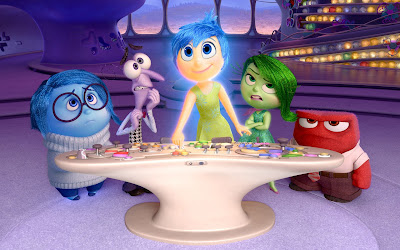After taking a year off, Pixar returns with an animated effort that ranks among the best of the studio's mostly terrific filmography. Like the rest of Pixar's classics, Inside Out is bursting with creativity and full of recognizable, relatable characters. Poignant, imaginative, fun, and funny, this is a must-see film for people of all ages.
Inside Out
Co-Writer/Director: Pete Docter
Starring: Amy Poehler, Phyllis Smith, Bill Hader, Mindy Kaling, Lewis Black
To call Inside Out an emotional roller coaster is accurate in both macro and micro terms, considering the film is about five anthropomorphized emotions who live inside a small control room in an eleven-year-old girl's head. Amy Poehler plays Joy, the bright, bouncy, Type-A leader who mostly runs the show by trying to keep the young girl, Riley, perpetually happy. She's occasionally overtaken by the perfectly-cast team of Disgust (Mindy Kaling), Fear (Bill Hader), Anger (Lewis Black), and Sadness (Phyllis Smith), who all begin to take on larger roles when Riley's family moves her from Minnesota to the unfamiliar San Francisco.
Inside Out establishes the world of Riley's mind in a tight opening sequence, flashing through her life's memorable moments and showing how the emotions were there every step of the way. The stakes are quickly set up: memories take the form of small glowing spheres, which are transported nightly into her memory banks to be recalled as needed. Core memories (the film's term for important experiences) are sent to a few different "islands" that make up the tenants of Riley's personality: family, hockey, goofball, honesty, and friendship. The move to San Francisco disrupts Joy's plans to keep Riley happy forever, and during a scuffle with Sadness, the two emotions are accidentally sucked up into a tube that blasts them across Riley's mind, leaving Disgust, Anger, and Fear to run the show as they struggle to make their way back.
Riley's mind is a triumph of design, with places like the absurd Imagination Land, the ingenious Dream Productions (a movie studio that produces her dreams), and a literal Train of Thought running wildly from station to station across the vastness of her head. Like many of the best pieces of entertainment, I asked myself why this had never been done before; Docter's film feels so right on every level, almost like the story, characters, and setting were an inevitability. That's when you know you've seen something timeless, and Inside Out is an instant classic.
Though I wasn't crazy about Pixar's most recent movie, Monsters University, the one element of it I appreciated more than anything else was how the "lesson" of the film is that you don't always get what you want. More often than not, pop culture collectively tells kids that if they dream big enough and work hard enough, they can do anything — and while that's a nice sentiment, it's not always true. In a constructive and empathetic fashion, Monsters University took the road less travelled and showed us that sometimes we simply don't have what it takes to achieve our goals. Inside Out continues the trend of teaching tough lessons. The plot follows the adventures of Riley's missing emotions as they try to get back to headquarters and the conflict that causes in Riley's behavior, but what the movie is actually about is embracing sadness in our lives. Most pieces of media we consume tell us to either suppress sadness or avoid it altogether, and Pixar is trying its best to remove that social stigma. Sometimes it's not only OK to be sad, but it's necessary to process things that happen to us and to allow us to ultimately lead healthy lives. It's an important message told in a smart way. (And while not as devastating as Docter's most recent movie Up, Inside Out does have one heart-wrenching sequence that left me wiping away tears.)
Intelligent, amusing, and full of laugh-out-loud visual gags and references, Inside Out is Pixar back at the top of its game.



No comments: